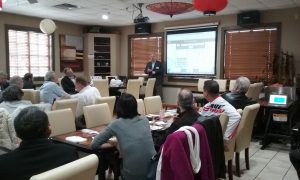We started discussion with the Haven app, an app which incorporates smartphone data in order to determine when someone has entered the room and/or tampered with personal assets such as a computer. It uses accelerometer, camera, light, microphone, and power data in order to determine activity around the smartphone. When triggered, (reaches the configured sensitivity threshold), notifications are sent via SMS or the Signal end-to-end encryption system. Remote access is available via TOR. The Android source code is open source.
We then briefly heard from Eric Brunner, who recently completed a prototype of a thin (~.25 mm), light-weight, plastic flex sensor. He demonstrated its touch and proximity sensing as shown in the linked slide (Eric Brunner Flex Sensor) He is seeking “your help if you have comments/suggestion on routes to monetization or other potential applications.

We then heard from UNT Electrical Engineering Professor Kamesh Namuduri on a locally deployable communication system for public safety. The system is intended to aid communication in emergency response zones, for example, person to person via voice/SMS/data or sensors/IoT system in the disaster response zone. Intended ground communication devices/radios may be smartphones for person to person comms or sensor/IoT systems for supporting emergency responders in the zone.

The system can be deployed by using balloon, drone, or other air vehicle. The system may facilitate radio communication within the response zone or may employ backhaul. Duration of deployment for emergency communication systems is limited by battery-life. One remedy to limited power (and bandwidth) was a tether with a power cable and a data cable. Further research is needed to understand optimal altitude of deployment and scaling the system to increase coverage area, among others. Professor Namuduri concluded with possible future work including networking the deployed systems to mitigate and improve the system. Professor Kamesh Namuduri Slides.




